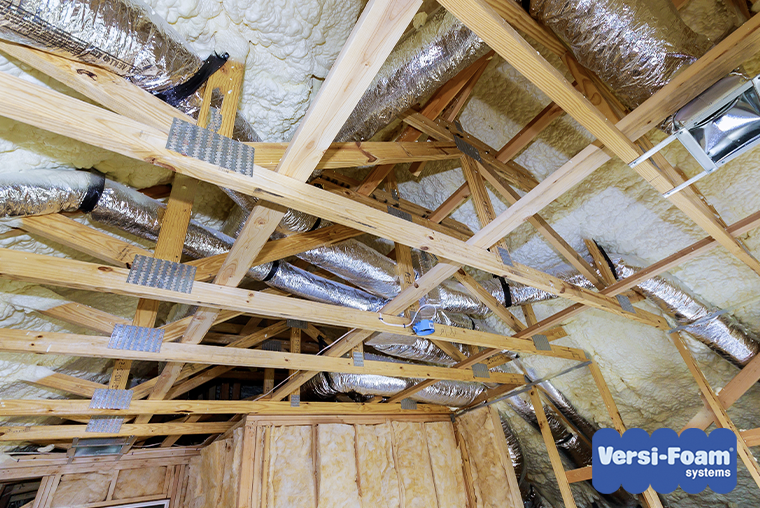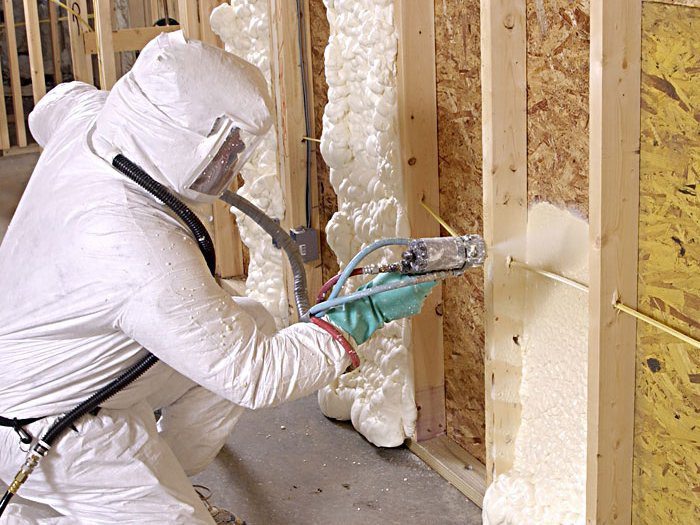Tips for Maintaining Your Spray Foam Insulation for Long-Term Efficiency
Tips for Maintaining Your Spray Foam Insulation for Long-Term Efficiency
Blog Article
Spray Foam: The Ultimate Solution for Air Sealing and Insulation
Spray foam insulation has emerged as a leading service for efficient air sealing and thermal insulation, offering an unique combination of buildings that establish it apart from standard techniques. Comprehending the full scope of its advantages, installation procedures, and contrasts with other insulation types is crucial for making educated choices.
What Is Spray Foam?
Spray foam is a flexible insulation product that combines the concepts of air securing and thermal resistance to improve energy performance in structures. Composed primarily of polyurethane or various other comparable compounds, spray foam is used as a liquid that expands upon call with surface areas, producing a strong, constant layer of insulation. This distinct residential property enables it to fill voids, fractures, and voids that typical insulation materials may ignore, offering a superior air seal.
There are two primary sorts of spray foam: open-cell and closed-cell. Open-cell spray foam is lighter and more versatile, using exceptional noise absorption and a lower R-value per inch - Spray Foam. On the other hand, closed-cell spray foam is denser, offering a greater R-value, wetness resistance, and included structural honesty to developing components
The application procedure usually entails specific tools, guaranteeing a smooth application that follows numerous substrates, consisting of concrete, metal, and timber. This flexibility makes spray foam appropriate for both brand-new constructions and retrofitting existing frameworks. Its capacity to create an impermeable obstacle considerably adds to decreasing power consumption and enhancing interior air top quality, thereby making it a favored selection among house owners and building contractors alike.
Advantages of Spray Foam Insulation
One of the most considerable benefits of spray foam insulation is its exceptional capacity to create a continuous air barrier, which efficiently reduces power loss. Unlike typical insulation products, spray foam increases to load cracks and spaces, making sure that air leak is drastically reduced. This characteristic not only enhances power performance yet additionally leads to decrease energy bills gradually.
In addition, spray foam insulation gives premium thermal resistance, adding to an extra steady indoor environment. Its high R-value per inch permits effective insulation in confined rooms, making it ideal for attic rooms, wall surfaces, and crawl areas. Furthermore, the moisture-resistant buildings of spray foam aid stop mold and mildew development, advertising healthier living conditions.
Another crucial advantage of spray foam insulation is its sound-dampening high qualities (Spray Foam). It effectively lowers sound transmission between areas, producing a quieter and much more comfy home atmosphere. The sturdiness of spray foam also attracts attention, as it does not sag or settle over time, preserving its performance throughout its life expectancy
How Spray Foam Functions
Understanding exactly how spray foam insulation works is essential for valuing its effectiveness in air sealing and thermal resistance. Spray foam insulation includes two key components: isocyanate and polyol material. When these elements are combined, they go through a chemical response that causes the product to expand quickly, developing a thick foam that loads spaces, splits, and cavities.
As the foam expands, it adheres to surface areas, creating an airtight seal that dramatically reduces air infiltration. This characteristic makes spray foam insulation extremely reliable at avoiding drafts and wetness infiltration, which can lead to energy loss and damage with time. Furthermore, the closed-cell variation of spray foam supplies superior thermal resistance due to its stiff structure, successfully decreasing warmth transfer.
The unique buildings of spray foam allow it to satisfy irregular click for source surface areas, making certain comprehensive protection and a seamless barrier. Because of this, spray foam insulation not only improves energy effectiveness however likewise adds to enhanced indoor air high quality by minimizing the build-up of contaminants and allergens. Eventually, understanding the mechanics behind spray foam underscores its role as a superior choice for insulation and air sealing in both business and domestic applications.
Installation Refine Introduction

Prior to installation, the area has to be sufficiently cleansed and prepped, ensuring that surface areas are without wetness, particles, and dirt. Due to the fact that impurities can endanger adhesion and overall performance, this action is vital. When the location is prepared, the application entails mixing the two elements of the spray foam, which broadens upon get in touch with and loads voids successfully.
Educated specialists need to conduct the installation, utilizing specialized equipment to guarantee consistent insurance coverage and optimum thickness. Safety and security precautions, including wearing safety equipment and making certain correct air flow, are important during this process. After application, the foam generally cures quickly, forming a solid barrier that enhances energy performance.
Contrasting Spray Foam to Typical Insulation
When reviewing insulation alternatives, spray foam insulation sticks out in comparison to standard materials such as fiberglass and cellulose. One of the key benefits of spray foam is its exceptional air sealing capabilities. Unlike fiberglass and cellulose, which can permit air infiltration, spray foam expands upon application, filling gaps and holes to develop an impermeable seal. This leads to enhanced Read More Here power effectiveness, as much less heated or cooled air leaves the home, leading to reduced utility expenses.
Additionally, spray foam supplies a higher R-value per inch than standard insulation types, using more effective thermal resistance in a thinner account. This characteristic is especially useful in spaces with restricted dental caries depth. Moreover, spray foam is resistant to wetness and mold growth, which can be a substantial worry with cellulose and fiberglass, particularly in damp settings.
Nonetheless, spray foam insulation generally brings a higher in advance price than its conventional equivalents. Homeowners should evaluate this first investment against lasting energy savings and performance advantages. Inevitably, while both insulation kinds serve their purpose, spray foam emerges as an advanced remedy for modern insulation demands, specifically in terms of air sealing and thermal efficiency.

Final Thought
In recap, spray foam insulation stands for a highly efficient option for accomplishing ideal air sealing and thermal resistance. Its distinct residential properties, consisting of wetness resistance and audio dampening, make it ideal for numerous applications in both brand-new buildings and retrofitting projects (Spray Foam). The preliminary costs might be higher compared to typical insulation products, the long-term benefits, such as considerable power financial savings and improved interior air top quality, warrant the financial investment and highlight its value in modern-day building techniques.
Spray foam insulation has actually emerged as a leading remedy for efficient air securing and thermal insulation, using a special mix of properties that establish it apart from conventional approaches.Spray foam is a flexible insulation product that integrates the concepts of air sealing and thermal resistance to boost energy performance in buildings.When reviewing insulation choices, spray foam insulation stands out in contrast to conventional products such as fiberglass and cellulose. Ultimately, look here while both insulation kinds offer their function, spray foam emerges as a much more innovative service for modern-day insulation needs, especially in terms of air securing and thermal effectiveness.
In recap, spray foam insulation stands for an extremely reliable service for accomplishing optimum air sealing and thermal resistance.
Report this page